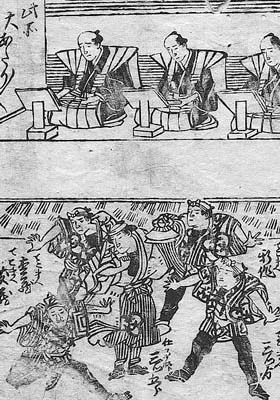| OMATSURI |
| Dance title | Mata Koko-ni Kabuki no Hanadashi |
| Common titles | Omatsuri Sarutori |
| Authors | Sakurada Jisuke II (lyrics) Kiyomoto Saibê (music) |
| History |
The star Bandô Mitsugorô III performed in the 6th lunar month of 1826 at the Ichimuraza in a 3-role Kiyomoto-based hengemono entitled "Mata Koko-ni Kabuki no Hanadashi". The 3 roles were Take-no-Uchi no Sukeneya (a legendary character famous for his extraordinary long life), a fisherman fighting a giant octopus and a tekomai festival dancer. The fisherman and the dancer are nowadays independent dances, which are staged under the respective titles of "Omatsuri" and "Amiuchi". |
| Key words | Shosagoto Kiyomoto Matsuri Hengemono Tobi Tekomai Sannô Matsuri |
| Summary |
A stylish and gallant Edo fireman boss is drawn into the merriment of the Sannô Matsuri, one of the main matsuri of the city of Edo. With the local youngsters and/or tekomai courtesans as his partners, he dances in the streets, expressing the air of excitement of a summer festival through his dance. |
| Trivia |
"Omatsuri" is considered as an auspicious dance for a star, who stages a comeback after a long sick leave. The number of dancers is not fixed. It is possible to stage "Omatsuri" with or without tekomai courtesans. |
 |
 |
|
Bandô Mitsugorô III playing the role of the firefighter in the dance "Mata Koko-ni Kabuki no Hanadashi", which was staged in the 6th lunar month of 1826 at the Ichimuraza (print made by Utagawa Kuniyasu I) |
An illustration taken from the illustrated playbill of the dance "Mata Koko-ni Kabuki no Hanadashi" |
|
|
| Contact | Main | Top | Updates | Actors | Plays | Playwrights | Programs | Links | FAQ | Glossary | Chronology | Illustrations | Prints | Characters | Derivatives | Theaters | Coming soon | News |